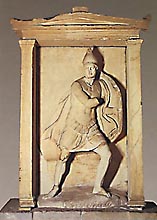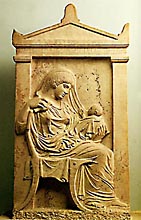 |
From the beginning of the 4th century onwards, the stela transformed itself into a true miniature shrine, and the figures were done in the round. The compositions had several figures, to lay stress on the weight and importance of family ties.
We can see this in the Ctesileus and Theano monuments, as in the monument for Proclides and his family. There was high drama in these scenes of farewell and in the lonely figures, one looking at the other (as for example with the figure of Aristonautes). Other kinds of grave monument were now becoming popular too. Most typically these were a statue; or a relief of a Siren, a lion, a goat, or a bull; the tall stela with crowning palmette; or a marble lekythos or loutrophoros with rich relief carving or inscribed decoration; or - though this was rarer - a marble lebes with griffin heads. |





